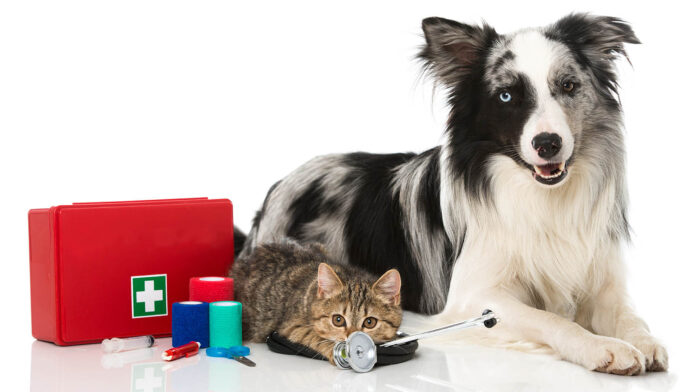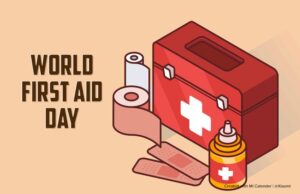Basic First Aid For Pets
Knowing basic first aid could prove vitally important if your pet has an accident or suddenly falls ill. If something happens to your dog, remember to stay calm and contact a vet as soon as possible.
First aid kit for pets
Keep a kit of basic first aid supplies for the pets in your household. Many items in a family first aid kit can be used for pets, too. Your veterinarian may recommend additional items for your kit based on your pet’s medical condition.
- Important phone numbers (veterinarian, emergency hospital, poison control, animal control, nonemergency police)
- A copy of your pet’s medical record, including any medications your pet is receiving
- Digital thermometer to take your pet’s temperature
- Muzzle to prevent bites (DO NOT muzzle your pet if they are vomiting.)
- Spare leash and collar
- Gauze roll for wrapping wounds or muzzling an injured animal
- Clean towels for restraining cats, cleaning, or padding
- Nonstick bandages or strips of clean cloth to control bleeding or protect wounds
- Self-adhering, nonstick tape for bandages
- Adhesive tape for securing bandages
- Scissors with blunt ends for safely cutting bandage materials
- Disposable gloves to protect your hands
- Small flashlight for examining eyes, wounds, etc.
- Tweezers to remove small foreign objects
- Eye dropper (or large syringe without needle) to give oral treatments or flush wounds
- Sterile lubricating jelly to protect wounds/eyes
- Activated charcoal to absorb poison (Use only if instructed to do so by your veterinarian or a poison control center.)
- 3% hydrogen peroxide to induce vomiting (Always contact your veterinarian or poison control center before inducing vomiting. Do not give more than one dose unless otherwise instructed by your veterinarian. Do not use hydrogen peroxide on wounds.)
- Saline solution for cleansing wounds or flushing eyes (Saline solution sold for use with contact lenses works well for most purposes.)
What to do in an emergency
When your pet has an emergency it can be hard not to panic. Try to stay calm, assess the situation, give your pet any necessary first aid, and call your vet. It’s helpful to remember the acronym: “Dr ABCs”
- Danger – keep yourself and others around you safe.
- Response – check if your pet responds to their name or touch.
- Airway – is their airway clear?
- Breathing – are they breathing?
- Circulation – do they have a pulse or heartbeat?
- Send – someone to ask for help!
In an emergency your pet is likely to feel frightened and may react differently to normal, they may even bite. Try to keep your voice as calm as possible and make slow, gentle movements to reassure them.
Choking or airway obstruction
This is an EMERGENCY. Transport your pet to a vet immediately. On the way check that the tongue is not causing the obstruction and if you can see an object which is causing the obstruction, try and remove it gently if possible. You can also attempt the Heimlich manoeuvre but follow these instructions with great caution and care.
Heimlich Manoeuvre – used for when your pet is choking
- Raise your pet onto their hind legs; the hind feet can rest on the floor or you can lift the pet off the ground depending on their body weight
- Place your pet’s backline against your front (for larger dogs you may have to lower your body position); your pet’s spine should be supported against your front at all times
- Place your arms around your pet just under the ribs, where the ribs finish and the abdomen starts
- Squeeze your pet firmly up and forward
- Repeat 4 times
OR
- Hold your pet upside down by their back legs, suspend in the air
- Firmly deliver a blow using your hand to the abdomen of the pet, in the area of where the ribs finish and the abdomen starts
- Repeat 4 times
Convulsions (also known as seizures or fitting)
First aid for convulsions
- Clear any danger away from your pet, make the room quiet and dark, wait until the convulsion has stopped before touching or moving your pet
- If unconscious, check your pet is breathing and there is no airway obstruction
- Do not place your fingers into your pet’s mouth or try to restrain your pet while convulsing
- Do not attempt to give food or water while your pet is convulsing
- Reassure your pet when he/she comes out of the convulsion
- After the convulsion has stopped, see a vet promptly
Eye injury or problem?
Eye injuries or problems should be considered emergencies. They can be extremely painful and if they are left untreated can quickly result in blindness. The most common causes of eye problems are trauma, corneal ulceration, eye prolapse and foreign bodies (such as grass seeds).
Any redness, swelling, increased tear production, squinting, closing of the eye/s, cloudiness or blueness of the eye ball, discharge, change in the size of the eye ball, uneven pupil size, a membrane (third eye lid) has come across the eye, pawing or rubbing the eye are all signs of an eye problem.
Eye injuries or problems should be seen by a vet immediately at the time they are noticed. Changes to the eye and its associated structures can occur quickly after an accident, even over a few hours.
DO NOT put any medications in your pet’s eye unless advised by your vet.
Penetrating objects
First aid care for penetrating objects
- Do not attempt to remove the item
- If possible and without causing any damage to your pet, reduce the size of the protruding part of the foreign body to 3-4 centimeters above the skin level
- If it is a penetrating wound to the chest, do not attempt to move the object, restrict your pet’s movement and if at all possible wrap the chest, covering the wound with a plastic wrap such as glad wrap, without putting any pressure on the impaled object.
- Control bleeding, but without applying pressure to the penetrating object
- Keep your pet warm
- See a vet immediately
Puncture & fight wounds
First aid for puncture or fight wounds if you know your pet has been in a fight
- See a vet promptly, a course of antibiotics will stop a deep infection from developing, but this must be done within 6-12 hours from when the fight happened
In the case of your pet sustaining severe attack wounds
- Control bleeding
- Keep your pet warm by wrapping them in a blanket
- Avoid being bitten or scratched as most pets are in shock and in pain
- See a vet immediately
Resuscitation
Resuscitation may consist of artificial respiration and/or cardiac massage.
- If your pet does not have a heart beat you should undertake cardiac massage.
- If your pet is not breathing but has a heart beat then perform artificial respiration.
- CPR (cardio-pulmonary resuscitation)is required if the animal is not breathing and does not have a heart beat. This involves a combination of massaging the heart and breathing for the animal (artificial respiration).
Artificial Respiration
If a pet stops breathing for 3-5 minutes there is a very poor chance of survival as brain damage is likely to have occurred.
- Lay your pet on their right hand side
- Check firstly for any obstructions in the mouth or throat
- Gently pull the tongue out of the mouth as far as it will comfortably go
- Gently hold the pet’s mouth closed without hurting the tongue
- Cup your hands around the nose
- For small pets, cover the pet’s mouth and nose with your mouth and gently blow into the nostrils and mouth until the chest rises
- For larger pets, cover the pet’s nose with your mouth while holding their mouth closed to reduce air escaping and gently blow into the nostrils until the chest rises
- Adjust the strength and volume of your blowing for the size of the pet – enough to see the chest rise
- Blow every 3-5 seconds for the first minute, check the pet after a minute to see if breathing has restarted and if there is a heart beat
- Continue a breath every 6 seconds, regularly check the pet for breathing and a heart beat
- Transport to a vet immediately, if you have a driver continue artificial respiration while in transit
Click here for CPR (cardio-pulmonary resuscitation) instructions.
Temperature changes
Warming your pet
- Wrap your pet in a thick blanket, jumper or layer of bubble wrap to stop the loss of body heat
- Place a heat pack close to your pet’s body, check the temperature of the heat pack and your pet regularly to avoid your pet getting over heated
- Warm the pet slowly
- Wet pets loose body heat rapidly, so dry your pet as quickly as possible
Cooling your pet
- Soak a towel in cool water, drizzle the water over your pet, concentrating on the head, stomach, under the neck, inner thighs and the pads of the feet
- Wrap your pet in a cool, wet towel
- For larger pets, gentle hosing or bathing with cool water is recommended followed by damp towels applied to the head and stomach
- Cool your pet slowly
- DO NOT apply ice packs to the pet
- Once your pet’s temperature comes down to 39 degrees celsius, stop cooling the pet and wrap in a dry towel or blanket
Wounds and grazes
Any break in the skin, such as an abrasion, cut, puncture or penetrating wound is susceptible to bacteria which can cause an infection. Damage to muscles, tendons and other vital structures of the body can also occur with deep wounds.
Most wounds require a thorough flushing using sterile saline, removal of contaminating matter and devitalized (dead) tissue, surgical repair of the wound, specialised wound dressings depending on the type of wound and medication. This must be performed by a veterinarian.
Graze type wound
A graze affects the surface layer of the skin and doesn’t usually go through the full thickness of the skin. Depending on the cause it can be a large or small wound, it can be either fairly clean or contaminated with road gravel, dirt, fur and grass.
First Aid for grazes
- Flush wound gently with saline/ clean tepid water
- Apply a sterile/ clean dressing
- See a vet promptly
Choking
Symptoms of choking can include:
- Difficulty breathing
- Excessive pawing at the month
- Choking sounds when breathing or coughing
- Blue lips or tongue
How to remove the blockage
If your dog is choking look into their mouth to see if anything is visible. If you see something then gently try to remove it but be careful not to push it further down their throat or be bitten.
If your pet collapses or you can’t remove the object then place both hands on the side of your dog’s rib cage and apply firm, quick pressure, or lay them on their side and strike the rib cage firmly with the palm of your hand three or four times. Repeat until it dislodges or you arrive at the vets.
Not breathing
If your pet stops breathing have someone call an emergency vet while you give first aid:
- Check to see if your pet is conscious and has a heartbeat
- Open your pet’s airway by gently grasping his tongue and pulling it forward out of the month until it’s flat
- Check their throat to see if there are any blockages
- Close your pet’s mouth and breath into his nose until you see his chest expand, continue once every five seconds – if your pet doesn’t regain consciousness get them to a vet as soon as possible.
No heartbeat
Have someone call a vet immediately while you begin emergency first aid:
- Feel and listen for a heartbeat
- Gently lay your dog on his side on a firm surface
- Place one hand under his chest for support and place the other over the heart (just behind the left front elbow)
- Press down on your pet’s heart 100-120 times per minute (press hard for larger animals and with less force for smaller ones)
- Alternate every 30 compressions with two rescue breaths
- Continue until you hear or feel a heartbeat or you have arrived at a vet.
Heatstroke
Symptoms of heatstroke include:
- Panting
- Difficulty breathing
- Excessive drooling
- Increased temperature
- Reddened gums
- Rapid heart rate
- Collapse
Cool your pet down
Call your vet immediately and follow advice on how to cool down your pet such as laying a damp towel over their body and applying cool (not cold) water to their paws and ear flaps. Move your pet away from any heat source and, if possible, open windows in your car to allow moving air to cool your pet slowly.
Shock
An animal could suffer shock as a result of severe injury or disease, or extreme fright. Possible symptoms include:
- A weak pulse
- Shallow breathing
- Collapsed
- Dazed eyes
Ensure your pet’s head is level with the rest of his body and transport him to the vet immediately. You can use a towel, blanket or muzzle to avoid being bitten if your dog is in pain.
Poisoning
If you believe your pet has been exposed to something harmful contact your vet as soon as possible. Symptoms of poisoning can include:
- Vomiting and diarrhoea
- Strange or unusual behaviour
- loss of appetite
- Pale gums
- Seizures
- Lethargy and collapse
Take note of the poison and check the label
Call the vet if you suspect your pet has eaten poison and, if you know what product it is, check the label for any instructions on what to do. Take it with you to the vet and inform them what and how much your pet may have consumed.
Seizures
Seizures can be a sign of epilepsy or another neurological disorder and possible symptoms can include:
- Signs of stress or worry
- Shaking
- Itching
- Trembling and paddling
- Toileting
- Foaming at the mouth
Prevent against further injury
Contact your vet as soon as you can and time the seizure. Keep any object that may harm your pet away from them, such as furniture. Use a blanket to stop injury if they are knocking against hard surfaces.
Don’t try to restrain your pet, keep the area quiet and calm, darken the room and avoid bright or flickering lights. When the seizure stops, keep your pet as quiet as possible.
Burns
Call the vet and flush the burn (thermal or chemical) with large quantities of cold water. If it’s a chemical burn, be careful not to flush any of the substances in their eyes.
Internal bleeding
Internal bleeding can be very serious, difficult to spot and requires immediate attention. Possible symptoms can include:
- Pale gums
- Weak rapid pulse
- Swollen abdomen
- Collapse
- Bleeding from the nose, mouth or rectum
Call the vet and transport your pet to the nearest emergency vet immediately while keeping them as warm and quiet as possible.
Bleeding
Severe bleeding can quickly become life-threatening. Contact your vet immediately and keep your pet calm.
How to stem the bleeding
- Press a clean tea towel over the wound
- Hold pressure on the wound for a minimum of three minutes and then check
- Apply a bandage and keep pressure on the wound (loosen pressure for 20 seconds every 15-20 minutes)
Transport your animal to the vet as soon as possible.
Fractures
Possible symptoms of a fracture can include swelling to the area or signs of pain such as limping or whining.
Keep your pet inside and limit their movement by putting them in a crate while you call the vet. If he cannot walk then gently lay him on a flat surface such as a board or stretcher to transport them to the vet.
When it’s best not to intervene
Dog fights
People are often bitten trying to break up a fight and can worsen the injuries to dogs when pulling them off of one another.
Dog in water
Owners who jump into the water to rescue a pet often find themselves in difficulty whereas their dog is often able to free themself.
Compiled & Shared by- Team, LITD (Livestock Institute of Training & Development)
Image-Courtesy-Google
Reference-On Request.





